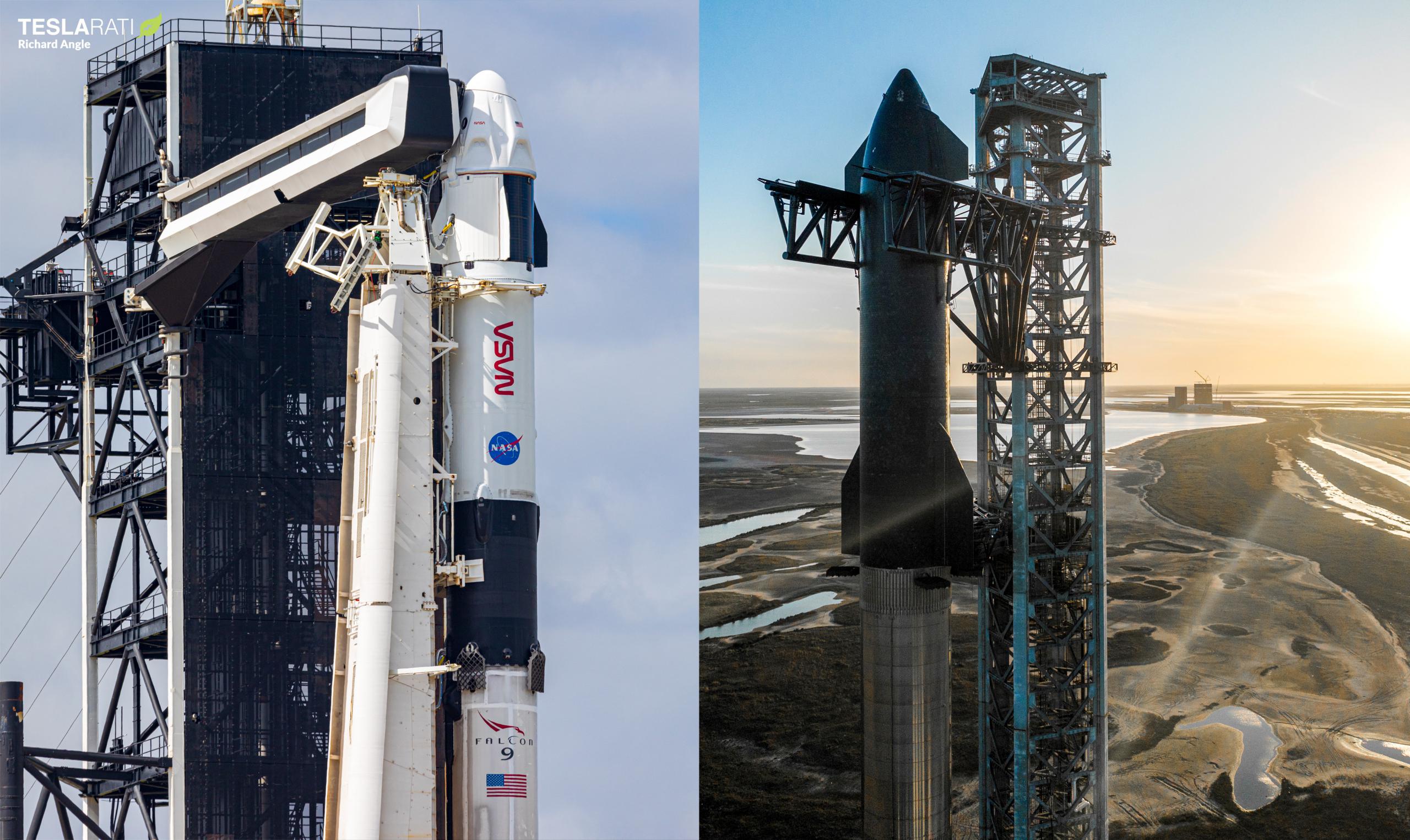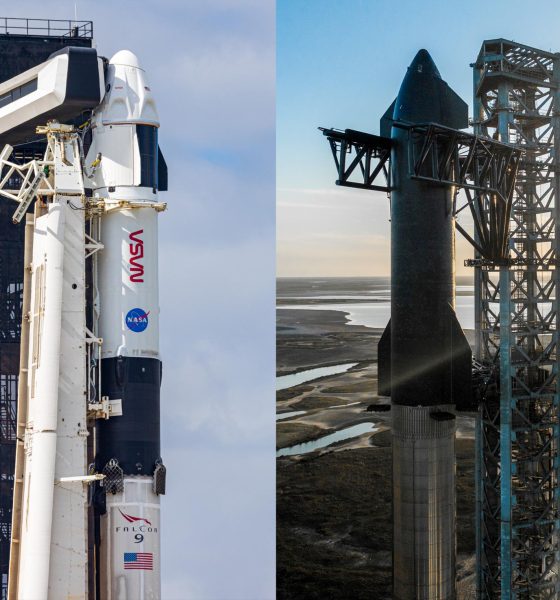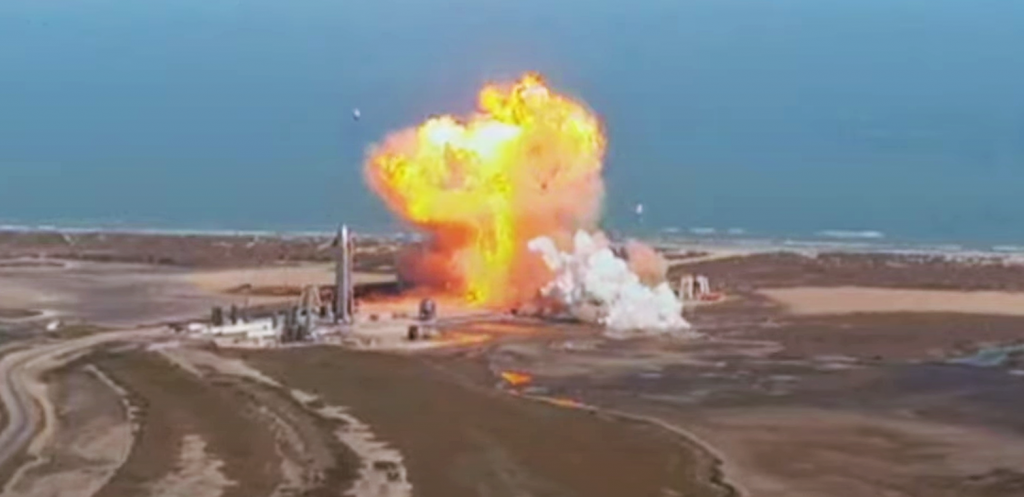

News
SpaceX considers second Crew Dragon launch pad to reduce risk from Starship
Reuters reports that SpaceX has proposed modifying a second Florida launch pad to support Crew Dragon missions after NASA raised concerns about the threat posed by plans to launch Starship out of the only pad currently certified for Dragon.
After more than a year of downtime, SpaceX restarted the construction of an orbital Starship launch site at NASA’s Kennedy Space Center LC-39A pad in late 2021. SpaceX has leased Pad 39A since 2014 and conducted 49 Falcon rocket launches out of the facility since its first use in 2017. Prior to SpaceX’s lease, Pad 39A supported 82 Space Shuttle launches from 1981 to 2011 and every Apollo Program launch to the Moon in the 1960s and 1970s, making it one of the most storied and well-used launch sites in the history of US spaceflight.
In 2018, Pad 39A began supporting launches of SpaceX’s Falcon Heavy, which was and still is the most powerful and capable rocket currently in operation. In May 2020, a Falcon 9 rocket and Crew Dragon spacecraft lifted off with two NASA astronauts in tow, marking SpaceX’s first human spaceflight and the United States’ first domestic astronaut launch of any kind since 2011. The next era of the historic pad could include Starship, a fully-reusable two-stage rocket that SpaceX has been developing in earnest since the mid-2010s. However, NASA is worried that a failure of that immense and unproven rocket could almost instantly destroy what is currently the only launch pad on Earth capable of launching the space agency’s astronauts to the International Space Station (ISS).
One certainly can’t blame NASA for worrying. In its latest iteration, SpaceX’s Starship 39A launch mount will sit roughly 1000 feet (~300m) East of Pad 39A’s existing Falcon launch facilities, which include a tower and arm that are needed for astronauts and cargo to access and board Crew and Cargo Dragons. The Starship mount is also around 1600 feet (~500m) northeast of Pad 39A’s lone horizontal integration hangar, without which Falcon launch operations would become far more difficult or even impossible.
For the Falcon pad and tower, there is a slight consolation: Starship’s own skyscraper-sized launch tower will be located directly between those Falcon facilities and Starship before and during launches and could partially protect them from any hypothetical blast. The hangar will be fully unprotected, however.


NASA is worried that if a Starship fails before or shortly after launch and explodes at or near its adjacent launch mount, it could destroy or damage the infrastructure the space agency and SpaceX need to launch Crew Dragon to the International Space Station (ISS). At the moment, Boeing – NASA’s second Commercial Crew partner – is likely a year or more away from its first operational astronaut launch, during which Falcon 9 and Crew Dragon will remain a single point of failure that could theoretically sever the space agency’s connection to its own space station at any moment.
In response to NASA’s concern, NASA executive Kathy Lueders – in an interview with Reuters – says that SpaceX has begun working with the agency on plans to both “harden” Pad 39A and modify its Cape Canaveral Space Force Station (CCSFS) LC-40 pad to support Dragon launches. According to Reuters, however, receiving approval to put those plans into action “could take months.” Depending on how significant the facilities LC-40 would need are, there’s also a chance that SpaceX would need to complete a new FAA environmental review to construct a crew access tower.

Meanwhile, Pad 39A is also the only launch pad in the world capable of supporting Falcon Heavy, which has also become an extremely important rocket for uncrewed NASA spacecraft launches, NASA’s plans to get cargo to its lunar Gateway space station, and to the US military. Modifying one of SpaceX’s other pads to support Falcon Heavy would likely be even harder and take even longer than adding Crew Dragon capabilities to LC-40. In both cases, it’s likely that NASA and the US military would strongly prefer – if they don’t eventually outright require – that SpaceX have backup options already constructed and ready to go before risking the destruction of Pad 39A with its first Starship launch.
39A’s Starship facilities could easily require another 6-12 months of work before they’ll be ready for launch, however, leaving a good amount of time for SpaceX to alleviate the concerns of its US government customers before they might actually start to disrupt plans for East Coast Starship launches.

Elon Musk
Elon Musk’s X will start using a Tesla-like software update strategy
The initiative seems designed to accelerate updates to the social media platform, while maintaining maximum transparency.

Elon Musk’s social media platform X will adopt a Tesla-esque approach to software updates for its algorithm.
The initiative seems designed to accelerate updates to the social media platform, while maintaining maximum transparency.
X’s updates to its updates
As per Musk in a post on X, the social media company will be making a new algorithm to determine what organic and advertising posts are recommended to users. These updates would then be repeated every four weeks.
“We will make the new 𝕏 algorithm, including all code used to determine what organic and advertising posts are recommended to users, open source in 7 days. This will be repeated every 4 weeks, with comprehensive developer notes, to help you understand what changed,” Musk wrote in his post.
The initiative somewhat mirrors Tesla’s over-the-air update model, where vehicle software is regularly refined and pushed to users with detailed release notes. This should allow users to better understand the details of X’s every update and foster a healthy feedback loop for the social media platform.
xAI and X
X, formerly Twitter, has been acquired by Elon Musk’s artificial intelligence startup, xAI last year. Since then, xAI has seen a rapid rise in valuation. Following the company’s the company’s upsized $20 billion Series E funding round, estimates now suggest that xAI is worth tens about $230 to $235 billion. That’s several times larger than Tesla when Elon Musk received his controversial 2018 CEO Performance Award.
As per xAI, the Series E funding round attracted a diverse group of investors, including Valor Equity Partners, Stepstone Group, Fidelity Management & Research Company, Qatar Investment Authority, MGX, and Baron Capital Group, among others. Strategic partners NVIDIA and Cisco Investments also continued support for building the world’s largest GPU clusters.
News
Tesla FSD Supervised wins MotorTrend’s Best Driver Assistance Award
The decision marks a notable reversal for the publication from prior years, with judges citing major real-world improvements that pushed Tesla’s latest FSD software ahead of every competing ADAS system.

Tesla’s Full Self-Driving (Supervised) system has been named the best driver-assistance technology on the market, earning top honors at the 2026 MotorTrend Best Tech Awards.
The decision marks a notable reversal for the publication from prior years, with judges citing major real-world improvements that pushed Tesla’s latest FSD software ahead of every competing ADAS system. And it wasn’t even close.
MotorTrend reverses course
MotorTrend awarded Tesla FSD (Supervised) its 2026 Best Tech Driver Assistance title after extensive testing of the latest v14 software. The publication acknowledged that it had previously criticized earlier versions of FSD for erratic behavior and near-miss incidents, ultimately favoring rivals such as GM’s Super Cruise in earlier evaluations.
According to MotorTrend, the newest iteration of FSD resolved many of those shortcomings. Testers said v14 showed far smoother behavior in complex urban scenarios, including unprotected left turns, traffic circles, emergency vehicles, and dense city streets. While the system still requires constant driver supervision, judges concluded that no other advanced driver-assistance system currently matches its breadth of capability.
Unlike rival systems that rely on combinations of cameras, radar, lidar, and mapped highways, Tesla’s FSD operates using a camera-only approach and is capable of driving on city streets, rural roads, and freeways. MotorTrend stated that pure utility, the ability to handle nearly all road types, ultimately separated FSD from competitors like Ford BlueCruise, GM Super Cruise, and BMW’s Highway Assistant.
High cost and high capability
MotorTrend also addressed FSD’s pricing, which remains significantly higher than rival systems. Tesla currently charges $8,000 for a one-time purchase or $99 per month for a subscription, compared with far lower upfront and subscription costs from other automakers. The publication noted that the premium is justified given FSD’s unmatched scope and continuous software evolution.
Safety remained a central focus of the evaluation. While testers reported collision-free operation over thousands of miles, they noted ongoing concerns around FSD’s configurable driving modes, including options that allow aggressive driving and speeds beyond posted limits. MotorTrend emphasized that, like all Level 2 systems, FSD still depends on a fully attentive human driver at all times.
Despite those caveats, the publication concluded that Tesla’s rapid software progress fundamentally reshaped the competitive landscape. For drivers seeking the most capable hands-on driver-assistance system available today, MotorTrend concluded Tesla FSD (Supervised) now stands alone at the top.
News
Elon Musk’s Grokipedia surges to 5.6M articles, almost 79% of English Wikipedia
The explosive growth marks a major milestone for the AI-powered online encyclopedia, which was launched by Elon Musk’s xAI just months ago.

Elon Musk’s Grokipedia has grown to an impressive 5,615,201 articles as of today, closing in on 79% of the English Wikipedia’s current total of 7,119,376 articles.
The explosive growth marks a major milestone for the AI-powered online encyclopedia, which was launched by Elon Musk’s xAI just months ago. Needless to say, it would only be a matter of time before Grokipedia exceeds English Wikipedia in sheer volume.
Grokipedia’s rapid growth
xAI’s vision for Grokipedia emphasizes neutrality, while Grok’s reasoning capabilities allow for fast drafting and fact-checking. When Elon Musk announced the initiative in late September 2025, he noted that Grokipedia would be an improvement to Wikipedia because it would be designed to avoid bias.
At the time, Musk noted that Grokipedia “is a necessary step towards the xAI goal of understanding the Universe.”
Grokipedia was launched in late October, and while xAI was careful to list it only as Version 0.1 at the time, the online encyclopedia immediately earned praise. Wikipedia co-founder Larry Sanger highlighted the project’s innovative approach, noting how it leverages AI to fill knowledge gaps and enable rapid updates. Netizens also observed how Grokipedia tends to present articles in a more objective manner compared to Wikipedia, which is edited by humans.
Elon Musk’s ambitious plans
With 5,615,201 total articles, Grokipedia has now grown to almost 79% of English Wikipedia’s article base. This is incredibly quick, though Grokipedia remains text-only for now. xAI, for its part, has now updated the online encyclopedia’s iteration to v0.2.
Elon Musk has shared bold ideas for Grokipedia, including sending a record of the entire knowledge base to space as part of xAI’s mission to preserve and expand human understanding. At some point, Musk stated that Grokipedia will be renamed to Encyclopedia Galactica, and it will be sent to the cosmos.
“When Grokipedia is good enough (long way to go), we will change the name to Encyclopedia Galactica. It will be an open source distillation of all knowledge, including audio, images and video. Join xAI to help build the sci-fi version of the Library of Alexandria!” Musk wrote, adding in a later post that “Copies will be etched in stone and sent to the Moon, Mars and beyond. This time, it will not be lost.”








